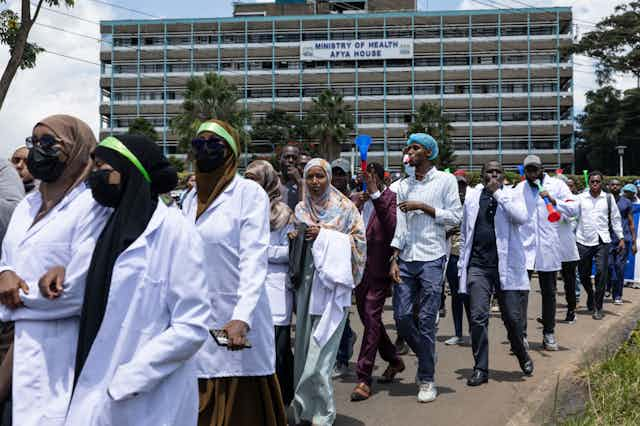At least 4,000 doctors are employed in Kenya’s public healthcare sector. Almost all of them went on strike on 14 March 2024, demanding the implementation of a labour agreement signed with the government in 2017. The agreement promised higher salaries, better working conditions and the recruitment of doctors. The Kenyan government said it didn’t have the money to honour the agreement, which was signed by a previous regime. Kahura Mundia teaches medical law and ethics, and is the deputy chair of the doctors’ union leading the strike. He explains the issues.
What grievances led to the doctors’ strike?
Doctors have taken several actions over the last seven years to get their grievances addressed. Doctors working in public hospitals have been pushing for the implementation of a collective bargaining agreement signed in 2017 between the Kenya Medical Practitioners, Pharmacists and Dentists Union, the national government and the country’s 47 county governments.
This agreement came about after all parties agreed to end a 100-day doctors’ strike that began in December 2016 and ended in March 2017. The agreement defined the basic terms of employment and benefits for all doctors. It was to be implemented fully and immediately from 1 July 2017, but it was not.
The latest doctors’ strike began on 14 March 2024. The government and the managers of one of Kenya’s top public hospitals went to the employment and labour relations court to stop the strike. The court suspended the strike on 15 March. It ordered that employers and doctors agree on the number of doctors, dentists, pharmacists and specialist doctors required to cover public health facilities and provide emergency care. This was set at two medical officers, two dentists, two pharmacists and two specialist doctors per facility. The court also ordered that union and government officials attend conciliation meetings to get a return-to-work formula.
Doctors’ union and government officials then held several meetings without being able to reach agreement.
The doctors’ grievances include:
a lack of comprehensive health insurance
delayed posting of medical interns
proposals to reduce interns’ salaries by close to 80%
staffing shortages in hospitals
a lack of staffing standards and norms.
National and county governments have additionally failed to facilitate training and development by denying doctors postgraduate study leave and not paying training fees for the past six years.
These are the same issues that occasioned the 2017 collective bargaining agreement.
Under the Abuja Declaration of 2001, African countries committed to allocating 15% of their government budgets to health. Kenya’s funding to the health sector has consistently fallen short of this target. Additionally, the allocation doesn’t ring-fence how much should be for the management of human resources.
This is one of the reasons there has been constant sectoral unrest – the failure to prioritise healthcare human resources. A collective bargaining agreement is meant to be reviewed every four years. In 2021, a new collective bargaining agreement proposal was shared with employers at national and county levels. No negotiations followed.
What are some of the gaps in Kenya’s healthcare provision?
Kenya has a large shortage of doctors. Current statistics show there are 2.3 doctors for every 10,000 people. The World Health Organization recommends a ratio of one doctor per 1,000 people.
The cost of healthcare is high. The average spend per person on healthcare is US$83.40. This is higher than the spend in neighbouring Uganda (US$33.90) or Tanzania (US$39.31). As a result, a majority of Kenyans can only afford to access healthcare in public facilities, which are inadequately staffed and equipped.
How have past negotiations shaped the latest strike?
Over the last 10 years, there has been labour unrest in the health sector because of failed commitments to fulfil the demands of healthcare workers.
The doctors’ union was established on 30 August 2011 after the enactment of the Kenyan constitution of 2010. Before this, attempts to register a union had been blocked by the government. This meant doctors couldn’t agitate for better working conditions.
The 2010 constitution also introduced county governments, which came into effect in 2013. Before this, doctors working in the public sector were centrally employed and managed by the health ministry. After 2013, doctors were posted across the 47 county governments. This made it more difficult to address issues touching on doctors’ welfare between national and county administrations.
Doctors’ first collective bargaining agreement was signed in 2013 with both levels of government. The implementation of this agreement, however, did not happen, which led to the 2016-2017 doctors’ strike. This ended with the signing of the 2017 deal, which was not implemented.
Kenya has had three government administrations since the doctors’ union was established. Each government administration has made commitments to improve working conditions but failed to honour them.
What have been the barriers to reaching a resolution?
The conditions placed by government officials have been a barrier – the first one being that doctors should call off the strike. In draft dispute settlement proposals in late April 2024, disagreement arose after issues raised in the strike notice were addressed without a comprehensive implementation plan. This led to a collapse in talks, owing to a lack of good faith and honest negotiations.
Good faith engagements entail coming up with clear and elaborate comprehensive solutions to each of the issues raised in a strike notice.
Doctors’ push for fair labour practices and collective bargaining has been guided by the provisions laid out by the Kenyan constitution and International Labour Organization conventions.
Dialogue on labour relations should be deliberate, fruitful, intentional and progressively undertaken. As a democratic country, keen on respecting the rule of law, Kenya cannot afford to mismanage doctors’ affairs by legitimising the violation of collective bargaining agreements, or discriminatory and exploitative labour practices.

